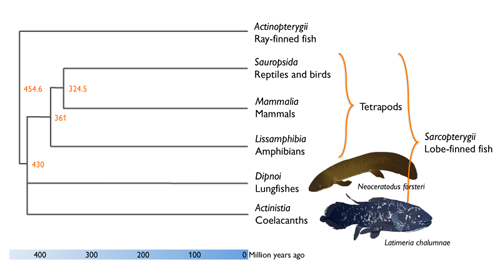
I've added the above illustration of a Coelacanth (Latimeria chalumnae) to my collection of illustrations together with one I had already made of a lungfish (open image). If you like you can download both high-res TIF-files here. The same Creative Common license applies as described under the "Download Illustrations" tab above.
I was prompted to add the coelacanth after reading a recent fascinating article about the secretive lives of these marvelous fish (via Deep Sea News) by Dr. Hans Fricke and co-workers. The article summarizes decades of study of the Latimeria population outside the island Grande Comore in the Indian ocean.
Latimeria live in large overlapping home ranges that can be occupied for as long as 21 years. Most individuals are confined to relatively small home ranges, resting in the same caves during the day. One hundred and forty five coelacanths are individually known, and we estimate the total population size of Grande Comore as approximately 300–400 adult individuals. <...> We estimate that the mean numbers of deaths and newcomers are 3–4 individuals per year, suggesting that longevity may exceed 100 years.
I'm astounded and my imagination is fueled by the intimate detail and vivid language with which the individual lives of these fishes is described! From the re-sighting of known individuals across several decades, the description of their cave-dwellings, which their share in family groups, their nocturnal hunting habits, and how they sometimes move outside of their familiar home-ranges. You can also read this recent interview with Fricke in Wired.
Together, the coelacanths (two described species in the taxon Actinistia) and lungfishes (three
The image below describes the relationships between the coelacanths, lungfishes and terrestrial vertebrates. As you can see they are less related to the ray-finned fishes, which is what we usually think about when we think of a fish, and more closely related to us terrestrial four-limbed vertebrates or tetrapods. This in effect makes "lobe-finned fishes" out of all of us, a thought that I personally find very amusing and satisfying.

Click on the image to see it full-size.
The ages displayed in the nodes of the tree are borrowed from The TimeTree of Life project. You should see them as estimates, calculated from different lines of data which usually give differing results. There is not a lot of evidence to date the divergence between coelacanths, lungfishes and tetrapods, so it's still not clear which of the two, coelacanths or lungfishes, started to diversify from a common ancestor first.
Fricke, H., Hissmann, K., Froese, R., Schauer, J., Plante, R., & Fricke, S. (2011). The population biology of the living coelacanth studied over 21 years Marine Biology, 158 (7), 1511-1522 DOI: 10.1007/s00227-011-1667-x
Hedges, S.B. (2009). Vertebrates (Vertebrata) The Timetree of Life, S. B. Hedges and S. Kumar, Eds. (Oxford University Press), 309-314 LINK: http://www.timetree.org/pdf/Hedges2009Chap39.pdf
No comments:
Post a Comment
Note: Only a member of this blog may post a comment.